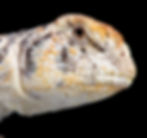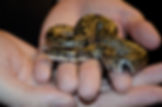Please call ahead to schedule an appointment. Occasionally, there are longer wait times when our staff is dealing with a medical emergency. We appreciate your patience. Book your appointment here >

Uromastyx Care Guide
Uromastyx Care Tips: Everything You Need To Know About Your Pet Uromastyx
Uromastyx lizards enjoy a relatively long lifespan for house pets, living anywhere from 15 - 20 years with the proper care. Adult Uromastyx can reach lengths of 10-18 inches, but the Egyptian Uromastyx is significantly larger, sometimes exceeding 30 inches in total length.

The Natural History of Uromastyx
Uromastyx, also called agamids, spiny-tailed lizards, dab lizards or mastigure lizards, is actually the name of a genus made up of 13 specific species that make their homes among rocky terrain where they can find vegetation and shelter. The most common of these species found in captivity are ornate Uromastyx, Egyptian Uromastyx and Nigerian/Saharan Uromastyx. Relatives of bearded dragons by way of the shared family Agamidae, wild Uromastyx can be found in North Africa, the Middle East and south-central Asia.


How to Care for Your Pet Uromastyx
Tanks and Housing
Like most lizards and other reptile pets, your Uromastyx is best housed in a glass tank enclosure. Juvenile and small adult Uromastyx (under 10 inches) should be provided a tank that measures at least 36 x 18 inches. Those measuring up to 15 inches should have a slightly larger tank at 48 x 18 inches and even larger pets should be housed in a 72 x 24 inch enclosure. Providing your lizard with enough space is important to simulating a semi-natural environment and allowing it to engage in natural behaviors.
Uromastyx Substrate
In the wild, Uromastyx live in rocky, sandy deserts. However, in captivity, any type of loose substrate is not recommended. Sand, dirt and even wood chips can cause impaction when ingested and respiratory issues for your Uromastyx. We recommend using reptile carpet or tile flooring on the bottom of your tank. You can also use paper towels, which make it easy to monitor urine and fecal output and catch any abnormalities early on.
How to Keep Your Uromastyx Tank Clean
Check on your Uromastyx tank regularly and clean it as often as possible. Change water and food 1-2x daily and spot clean by removing any feces, urates or mess. Deep clean once a week by removing and cleaning all accessories and wiping down the tank. Harsh cleaning chemicals can be harmful to your Uromastyx. We recommend cleaning with vinegar and warm water; it’s a safe and effective way to clean the tank and keep your pet lizard clean.
Providing the Right Climate for Your Uromastyx
Uromastyx lizards prefer a hot climate and need a specific area of their enclosure kept at even higher temperatures for basking. Use digital thermometers to ensure that the cool side of the tank stays between 80-85°F while the warm side is maintained at 90-100°F. The basking area should be even hotter at 110-120°F. This can be achieved by adding a 75w-150w heat bulb depending on your tank size and the distance of the light from the basking area.
To create these conditions, you can use a combination of basking bulbs, ceramic heat emitters and UVB lighting. Avoid heat rocks and heat pads, and keep lighting suspended at a safe height, out of your pet’s reach. Close contact with any of these can severely burn your Uromastyx.
UVB lighting should be provided for 10-12 hours a day with bulbs made for desert species. By using an automatic timer, you can help your lizard maintain a regular day/night cycle.
Finally, your Uromastyx will also need a humid place to hide in. The area should be 2-3 times the length of the lizard so it can enter and exit comfortably. You can create this by placing a warm wet paper towel under the hide daily.
Uromastyx Diet and Nutrition
What Do Uromastyx Eat?
Did you know that Uromastyx lizards get almost all of their water from food? That’s one of the reasons they are so well-adapted to a desert environment. While they should be given a bowl of fresh water, they may not drink from it - so don’t be alarmed. Instead, always offer them fresh food that has not dried out before consumption. You can also spray the greens you feed your Uromastyx with water for added hydration.
If you are worried that your Uromastyx isn’t getting enough water, encourage it to drink by dropping water onto its nose once or twice a week. Soaking is another great way to keep your Uromastyx hydrated. Place your pet in a shallow dish of water for about 15-20 minutes at least once weekly. This allows them to soak up some water through their cloaca and also aids in shedding!
Though known to occasionally enjoy insects, Uromastyx lizards are mostly herbivorous. They need fresh green leafy vegetables such as:
-
Collard greens
-
Kale
-
Mustard greens
-
Dandelions (including flowers)
-
Escarole
-
Endive
Variety is key, so make sure to offer a mixture of greens daily.
Spinach should be avoided as it can cause bladder stones in your Uromastyx. Avocados and the seeds of fruits are harmful to all pets. Citrus can be too acidic and cause gastrointestinal issues, so don’t feed your lizard oranges, limes, lemons, etc..
Fruits can also be added to your Uromastyx diet, but must be given sparingly. Fruit can be added along with greens once a week. Think of fruit as the croutons on a salad; this should be your fruit to vegetable ratio.
Though not strictly necessary, you can feed your Uromastyx insects including crickets, mealworms and dubia roaches. We recommend offering about 5 insects once or twice a month.
Recommended Treats and Supplements
In order to guarantee that your blue-tongued skink is getting all the nutrition and vitamins it needs, dust its food with a reptile multivitamin once to two times per month, and dust a calcium carbonate supplement without D3 once per week, and with Vitamin D3 at every feeding.
Encouraged Treats and Supplements
Generally speaking, the best practice is to provide a varied and nutritious diet for your Uromastyx so that supplementation isn’t necessary.
That being said, some supplements are important. Each day, dust your pet’s food with calcium powder without D3. Once a week, dust with calcium powder with D3, and give multivitamins one or two times a month.
Lentils (soaked in water) can also be given as an occasional treat.
Uromastyx Behavior
One of the factors that make Uromastyx lizards enjoyable pets is their gentle and inquisitive nature. Capable of recognizing you, Uromastyx lizards get used to being handled over time and don’t normally bite, except for some Moroccan Uromastyx.

Medical Care for Uromastyx Skinks
While Uromastyx can enjoy a relatively long life compared to many other household pets, there are several common health concerns to be on the lookout for and discuss with your reptile vet:
-
Malnutrition, including secondary nutritional hyperparathyroidism (metabolic bone disease)
-
Dehydration
-
Reproductive disease
-
Shedding problems
-
Intestinal parasites
-
Respiratory or eye infections
-
Kidney disease
-
Bladder stones
Many commonly seen conditions are the result of malnutrition and/or inadequate housing and are preventable.
Make sure to avoid:
-
Keeping your Uromastyx in the same enclosure as another reptile species. Housing alone is best
-
Sharp edges in the enclosure
-
Dangerous furnishing in the enclosure, such as something that could fall on your Uromastyx.
-
Free roaming of the house or interaction with cats, dogs or other predators
-
Direct contact with heating elements or light sources
-
Excessive handling
-
Small children or inexperienced people handling your Uromastyx
-
Unsanitary or dusty housing
-
Allowing the enclosure to get too hot or too cold
Especially if it’s your first time caring for a Uromastyx, recognizing the telltale signs of health problems can be a unique challenge.
One of the best ways to guarantee you are providing the necessary care and catching problems early is to schedule regular checkups with your exotic pet veterinarian, who will always be able to advise you on your next steps as a pet owner.
If you suspect an issue with your Uromastyx or simply haven’t brought it in for a while, schedule a check up now so you don’t have to worry later.
Boarding for Uromastyx
In emergencies, we offer boarding for our Uromastyx patients when required after a medical procedure, or if a family will be on an extended trip away. Rest or travel easily knowing that the team at LIBEVC is taking care of your pet lizard.
Learn more about our Medical Boarding Services.
Reach Out!
If you are concerned that your pet agamid might be suffering from any health issues, or if you have questions about how to provide them with a healthy living environment, feel free to contact us via email or phone with any questions. The veterinarian team at Long Island Bird and Exotics Veterinary Clinic will be happy to provide you with reliable information about your pet.











